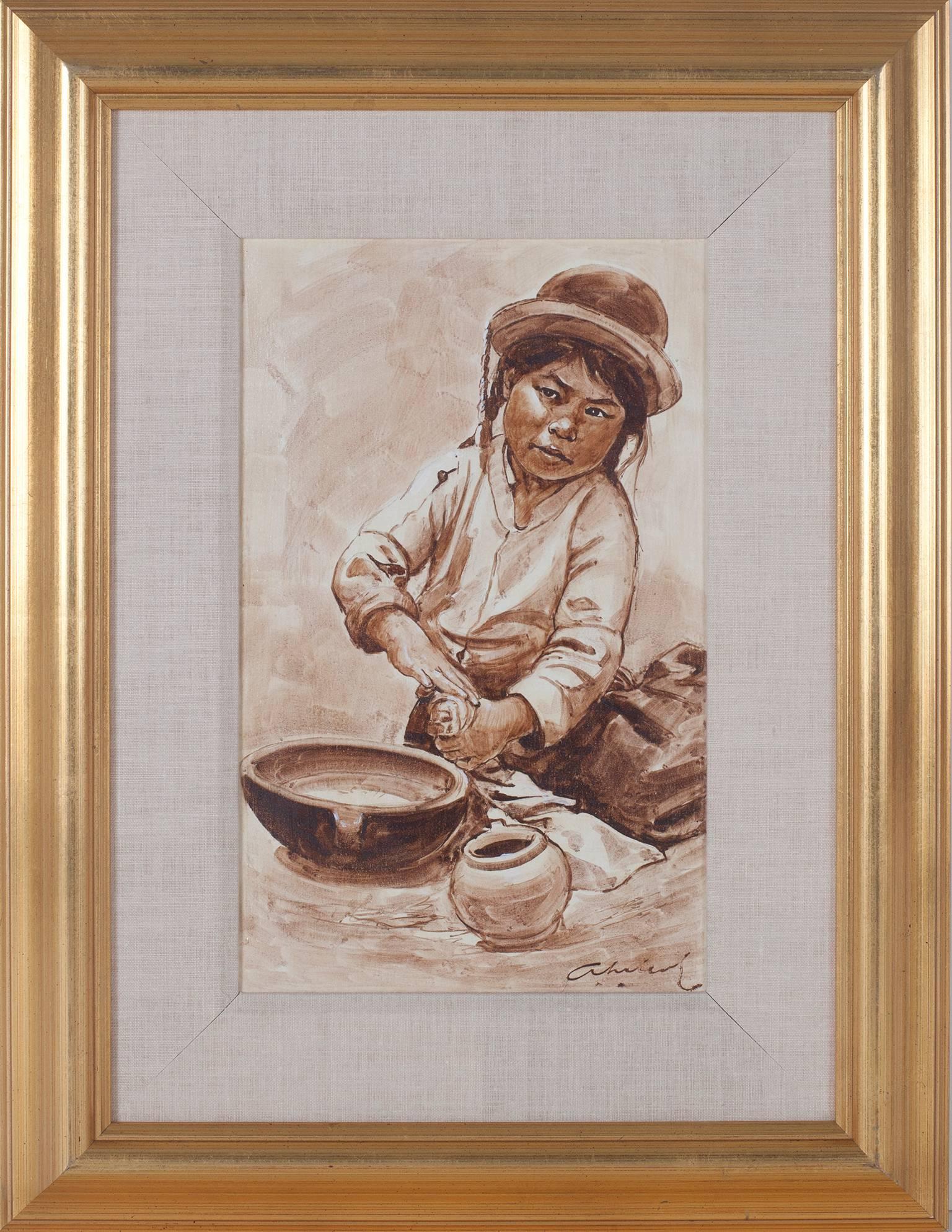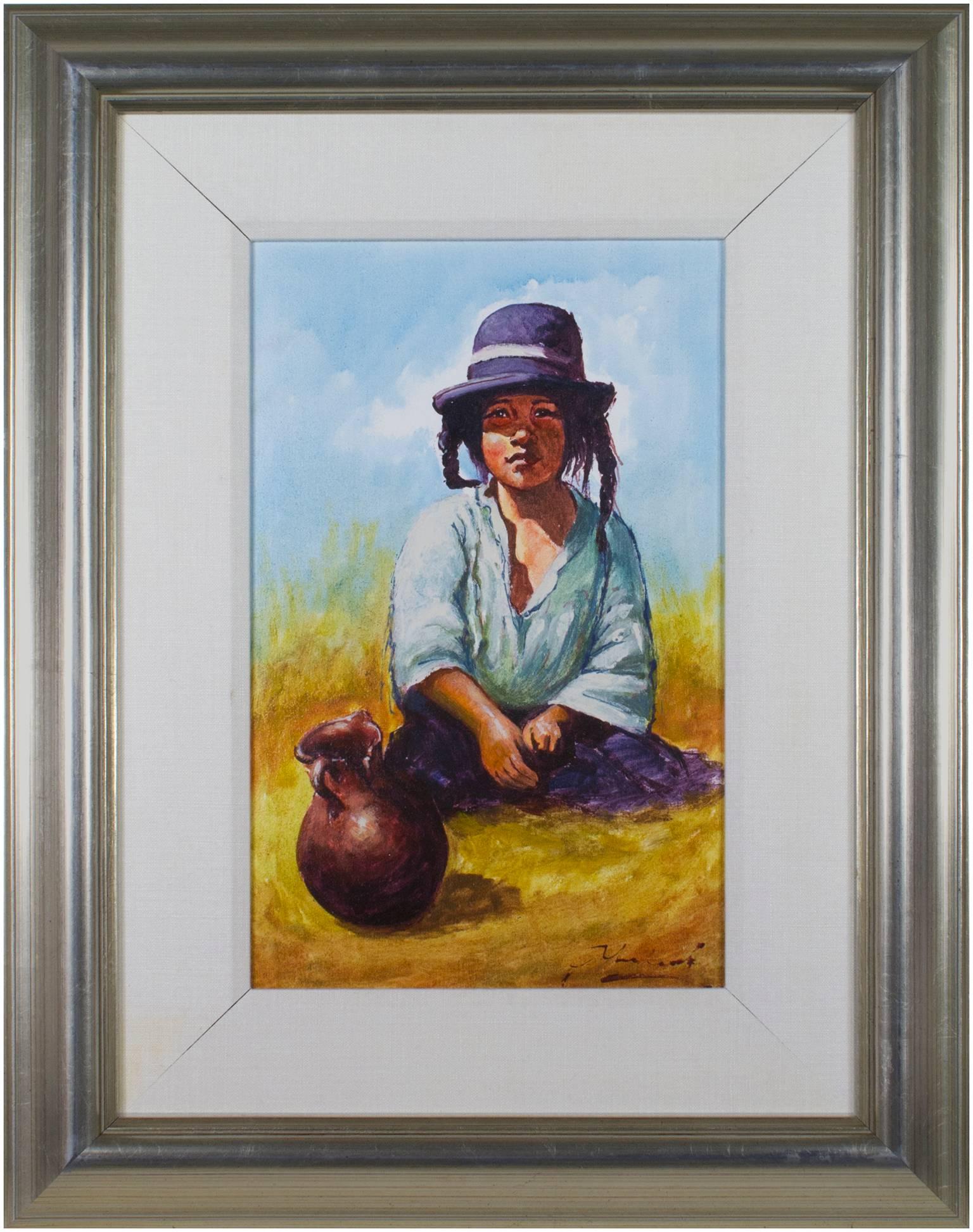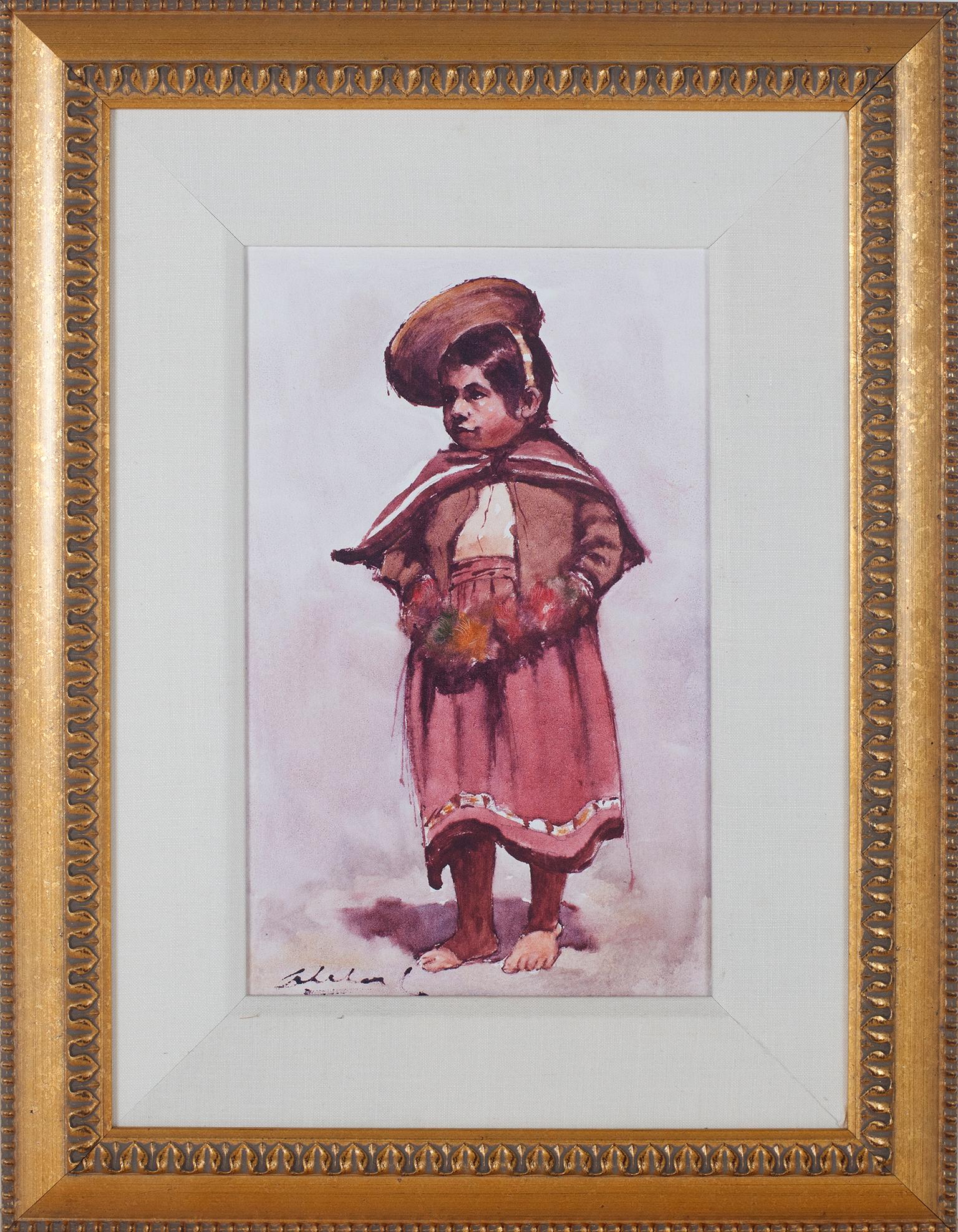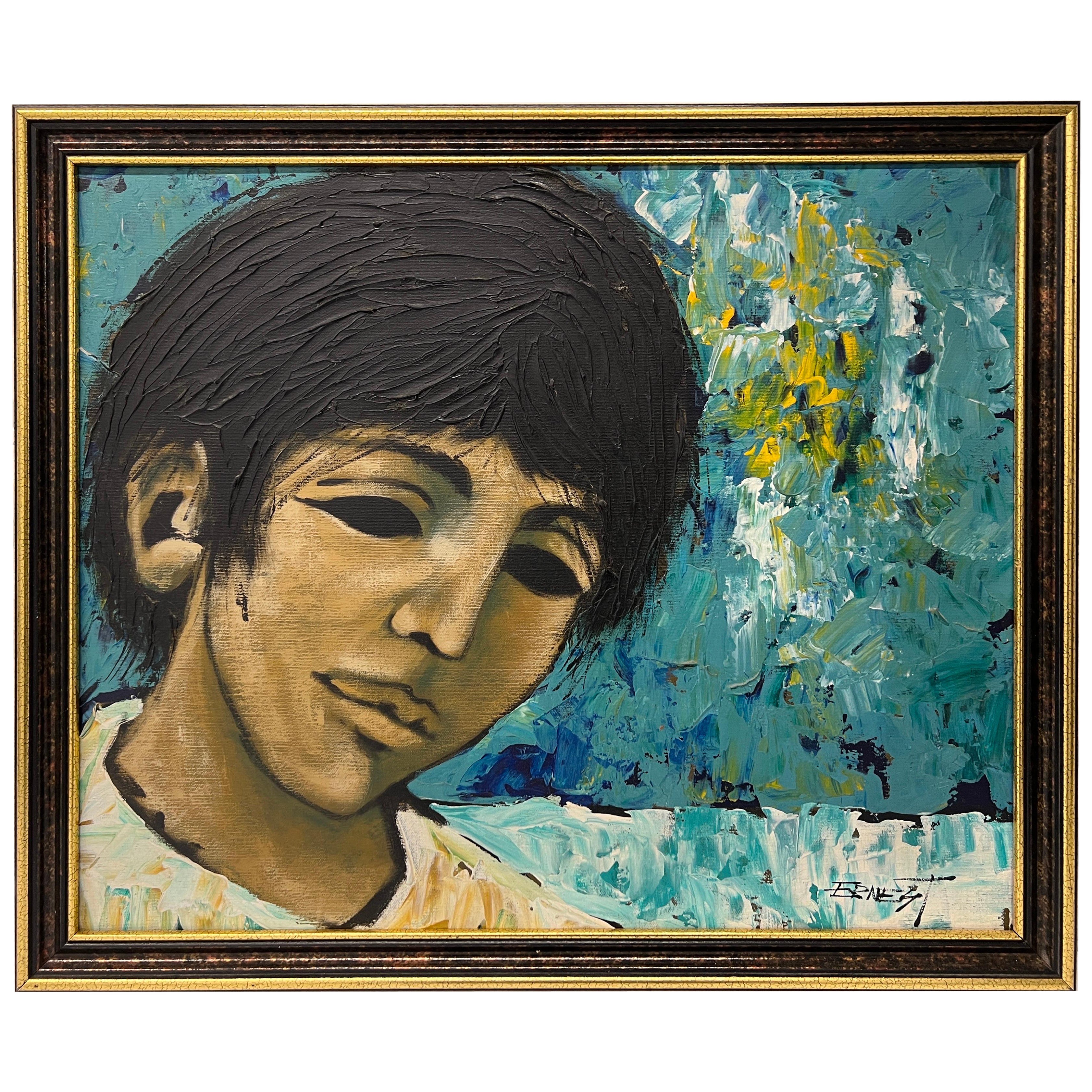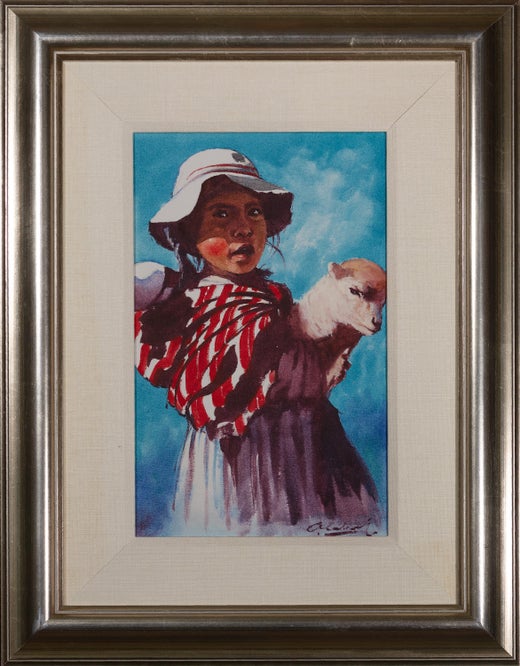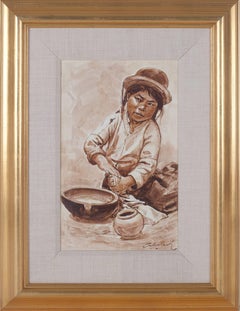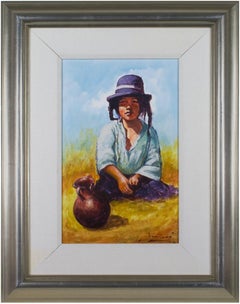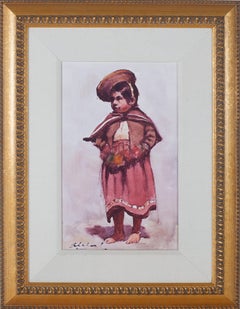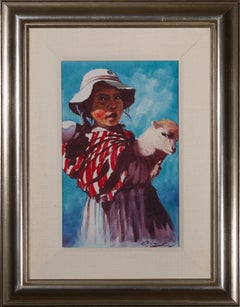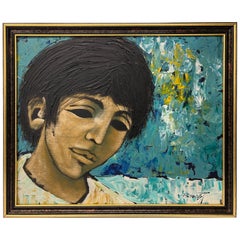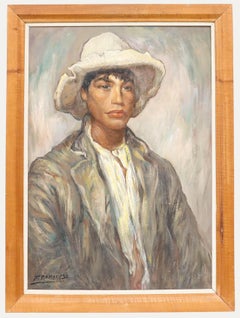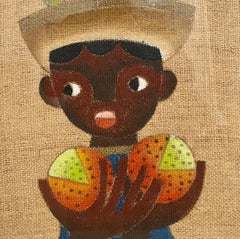Items Similar to "Nino Trabajador (Child Carving Wooden Bowl) - Ayacucho, " Oil on Canvas signed
Want more images or videos?
Request additional images or videos from the seller
1 of 9
Abelardo Marquez Velazquez"Nino Trabajador (Child Carving Wooden Bowl) - Ayacucho, " Oil on Canvas signed1992
1992
$1,650
£1,241.47
€1,434.29
CA$2,331.88
A$2,531.97
CHF 1,340.86
MX$31,034.69
NOK 16,593.71
SEK 15,680.17
DKK 10,704.97
About the Item
"Nino Trabajador (Child Carving Wooden Bowl) - Ayacucho" is an original oil painting by Abelardo Marquez. It depicts a boy carving a bowl out of wood. This painting was completed in a monochromatic sepia tone. The artist signed the piece in the lower right.
15 3/4" x 9 3/4" art
25 7/8" x 19 7/8" frame
Abelardo Marquez was born in 1938 in Lima, Peru, and studied art at the Escuela De Bellas Artes located in Lima. Marquez paints breathtaking landscapes of Peru, mainly the Andes Mountains where the artist resides. He also specializes in depicting the people of his native country such as mothers and children both at work and as play. The charming figurative works of the artist show off the Peruvian villages as well as the people in their native costumes. Marquez’s artworks are known for their vibrant color and possess an impressionist quality of light.
- Creator:Abelardo Marquez Velazquez (1942, Peruvian)
- Creation Year:1992
- Dimensions:Height: 25.875 in (65.73 cm)Width: 19.875 in (50.49 cm)
- Medium:
- Movement & Style:
- Period:
- Condition:
- Gallery Location:Milwaukee, WI
- Reference Number:Seller: 9461g1stDibs: LU60532427133
Abelardo Marquez Velazquez
Abelardo Marquez was born in 1938 in Lima, Peru, and studied art at the Escuela De Bellas Artes located in Lima. Marquez paints breathtaking landscapes of Peru, mainly the Andes Mountains where the artist resides. He also specializes in depicting the people of his native country such as mothers and children both at work and as play. The charming figurative works of the artist show off the Peruvian villages as well as the people in their native costumes. Marquez’s artworks are known for their vibrant color and possess an impressionist quality of light.
About the Seller
4.9
Platinum Seller
Premium sellers with a 4.7+ rating and 24-hour response times
Established in 1966
1stDibs seller since 2017
442 sales on 1stDibs
Typical response time: 3 hours
- ShippingRetrieving quote...Shipping from: Milwaukee, WI
- Return Policy
Authenticity Guarantee
In the unlikely event there’s an issue with an item’s authenticity, contact us within 1 year for a full refund. DetailsMoney-Back Guarantee
If your item is not as described, is damaged in transit, or does not arrive, contact us within 7 days for a full refund. Details24-Hour Cancellation
You have a 24-hour grace period in which to reconsider your purchase, with no questions asked.Vetted Professional Sellers
Our world-class sellers must adhere to strict standards for service and quality, maintaining the integrity of our listings.Price-Match Guarantee
If you find that a seller listed the same item for a lower price elsewhere, we’ll match it.Trusted Global Delivery
Our best-in-class carrier network provides specialized shipping options worldwide, including custom delivery.More From This Seller
View All"Nina Alfarera (Child Making Pottery) - Puno, " Oil on Canvas signed by Velazquez
By Abelardo Marquez Velazquez
Located in Milwaukee, WI
"Nina Alfarera (Child Making Pottery) - Puno" is an original oil painting by Abelardo Marquez. It depicts a young girl sculpting pottery. This painting was completed in a monochromat...
Category
1990s Contemporary Figurative Paintings
Materials
Canvas, Oil
"Nina Ponema Puno (Young Girl from Puno), " Oil on Canvas signed by A. Velazquez
By Abelardo Marquez Velazquez
Located in Milwaukee, WI
"Nina Ponema - Puno (Young Girl from Puno)" is an original oil painting on canvas by Abelardo Marquez. The artist signed the piece in the lower right. This painting depicts a young g...
Category
1990s Contemporary Portrait Paintings
Materials
Canvas, Oil
Contemporary figurative oil painting Latino child subject red costume signed
By Abelardo Marquez Velazquez
Located in Milwaukee, WI
"Vestido Regional (Girl in Her Regional Costume)" is an original oil painting on canvas by Abelardo Marquez. The artist signed the piece lower left. This artwork features a young girl in a pink and purple...
Category
1990s Contemporary Figurative Paintings
Materials
Canvas, Oil
Latino Female Figure Portrait Latin Peruvian Culture Sheep Realism Color Signed
By Abelardo Marquez Velazquez
Located in Milwaukee, WI
"Nina Alfarera (Child Making Pottery) - Puno" is an original oil painting by Abelardo Marquez.It depicts a young girl holding a baby alpaca or llama. This painting was completed in b...
Category
1990s Contemporary Figurative Paintings
Materials
Canvas, Oil
"Mujer de Cajamarca, " Oil Painting on Jute signed by Ernesto Gutierrez
By Ernesto Gutierrez (b.1941)
Located in Milwaukee, WI
"Mujer de Cajamarca" is an original oil painting on jute by Ernesto Gutierrez. The artist signed the piece in the lower right. It depicts a woman seated in front of an archway.
16"...
Category
Early 2000s Contemporary Figurative Paintings
Materials
Jute, Oil
Latino Female Figure Portrait Latin Peruvian Culture Native Realism Color Signed
By Abelardo Marquez Velazquez
Located in Milwaukee, WI
"Vestido de la Region (Regional Costume) - Cuzco" is an original oil painting on canvas by Abelardo Marquez. The artist signed the piece in the lower right. This painting depicts a w...
Category
1990s Contemporary Portrait Paintings
Materials
Canvas, Oil
You May Also Like
"MEXICAN POTTERY DECORATOR"
By Bette Lou Voorhis
Located in San Antonio, TX
Bette Lou Voorhis "Mexican Pottery Decorator"
Born 1930
Austin Artist
Image Size: 36 x 24
Frame Size: 43 x 31
Medium: Oil
Biography:
Bette Lou Voorhis...
Category
1950s Impressionist Landscape Paintings
Materials
Oil
Mid Century Spanish Oil Painting of A Young Boy - Signed Ernest
Located in Atlanta, GA
Spanish, 20th century.
A vintage oil painting depicting a young boy. The artist used a wonderful array of colors to accent the boy's profile. Signed to lower right.
Category
20th Century Spanish Mid-Century Modern Paintings
Materials
Canvas, Paint
$540 Sale Price
20% Off
Francisco Ramoneda (1905-1977) - Argentinian Mid 20th Century Oil, Farmer Boy
Located in Corsham, GB
An expressive portrait of a farmer boy wearing a wide-brimmed hat and a loose-fitting coat by the Argentinian artist Francisco Ramoneda (1905-1977). The artist has used confident bru...
Category
20th Century Portrait Paintings
Materials
Oil
Folk Art Mexican Boy Oil Painting on Burlap Charming Naive African American Art
By Jose Maria de Servin
Located in Surfside, FL
Framed 29 X 23
Image 18 X 24
The sweetness that characterizes the work of Mexican painter Jose Maria de Servin (1917-83) is a melancholy and placid one. While he worked in the most modern of styles, he adapted it to an anecdotal folk-art approach distinctly his own.
When he was an infant, de Servin's family moved with him to Guadalajara. A city of history and culture, Guadalajara had a thriving artistic community with strong connections to Europe. His brothers Antonio and Miguel became artists as well, and in later years they worked collaboratively. As a teenager, de Servin studied at one of Mexico's Schools of Open-Air Painting, free art-teaching institutions sponsored by the government.
Later de Servin became a pupil of the painter Chucho Reyes, known for his improvisational watercolor variations on traditional Mexican themes. This interest in imagery particular to Mexico would be of great significance to de Servin. De Servin also studied under the more traditional painter Jose Vizcarra. In the early 1930s de Servin joined the Pintores Jovenes de Jalisco, or Young Painters of Jalisco.
An influence of critical importance to de Servin was Pablo Picasso. One of the originators of Cubism, the Spanish painter soon departed from its quasi-scientific and optical basis to create lively and humorous geometrical abstractions. It was this Cubism, personal and decorative, that de Servin adopted. His earliest Cubist works mimic Picasso, while during the second stage of his career, his works become smooth and polished, with an emphasis on gentle surface textures.
After these cautious years, however, a rough boldness enters along with dominating colors of earth and sand. Modernists like de Servin were interested in exploring what they considered primitive artmaking styles. The adoption of a native manner and native themes is in keeping with Modernist tenets, as is the use of nontraditional materials. De Servin's portraits of peasants, large-eyed and simply rendered, recall children's drawings. The rough burlap ground contrasts with the playful imagery and delicate range of color. The figures, all children or child-like adults, are all curves and simple shapes arranged harmoniously. De Servin's cubism is free from grotesquerie as it celebrates the simplicity of its subjects.
De Servin worked with the social-realist Jose Orozco on several large mural commissions in Guadalajara, including one at the Legislative Palace. While their styles were dissimilar, both made use of Mexican imagery to glorify the common people. A sought-after muralist in his own right, de Servin brought the rich colors and endearing characters of his panels to his larger-scale work.
For 15 years, de Servin taught summer art classes at the University of Arizona. His career was marked by many one-man shows, both in North America and Europe. In recent years, his striking style has attracted increased notice from critics and the public.
His style is a unique conglomerate of tradition, history, legends, heroes, old customs and folklore. It is a self-standing style, recognizable, cheerful, whimsical and a happy creation. Naïve art is any form of visual art that is created by a person who lacks the formal education and training that a professional artist undergoes (in anatomy, art history, technique, perspective, ways of seeing). Unlike folk art, naïve art does not necessarily evince a distinct cultural context or tradition. Naïve art is recognized, and often imitated, for its childlike simplicity and frankness. Paintings of this kind typically have a flat rendering style with a rudimentary expression of perspective.
One particularly influential painter of "naïve art" was Henri Rousseau (1844–1910), a French Post-Impressionist who was discovered by Pablo Picasso. Naïve art is often seen as outsider art that is by someone without formal (or little) training or degree. While this was true before the twentieth century, there are now academies for naïve art. Naïve art is now a fully recognized art genre, represented in art galleries worldwide.
Museums devoted to naïve art now exist in Kecskemét, Hungary; Riga, Latvia; Jaen, Spain; Rio de Janeiro, Brasil; Vicq France and Paris. "Primitive art" is another term often applied to art by those without formal training, but is historically more often applied to work from certain cultures that have been judged socially or technologically "primitive" by Western academia, such as Native American, sub saharan African or Pacific Island art (see Tribal art). This is distinguished from the self-conscious, "primitive" inspired movement primitivism. Another term related to (but not completely synonymous with) naïve art is folk art. There also exist the terms "naïvism" and "primitivism" which are usually applied to professional painters working in the style of naïve art (like Paul Gauguin, Mikhail Larionov, Paul Klee).
At all events, naive art can be regarded as having occupied an "official" position in the annals of twentieth-century art since - at the very latest - the publication of the Der Blaue Reiter, an almanac in 1912. Wassily Kandinsky and Franz Marc, who brought out the almanac, presented 6 reproductions of paintings by le Douanier' Rousseau (Henri Rousseau), comparing them with other pictorial examples. However, most experts agree that the year that naive art was "discovered" was 1885, when the painter Paul Signac became aware of the talents of Henri Rousseau and set about organizing exhibitions of his work in a number of prestigious galleries. The Earth Group (Grupa Zemlja) were Croatian artists, architects and intellectuals active in Zagreb from 1929 to 1935. The group included the painters Krsto Hegedušić, Edo Kovačević, Omer Mujadžić, Kamilo Ružička, Ivan Tabaković, and Oton Postružnik, the sculptors Antun Augustinčić, Frano Kršinić, and the architect Drago Ibler. A term applied to Yugoslav (Croatian) naive painters working in or around the village of Hlebine, near the Hungarian border, from about 1930. Some of the best known naive artists are Dragan Gaži, Ivan Generalić, Josip Generalić, Krsto Hegedušić, Mijo Kovačić, Ivan Lacković-Croata, Franjo Mraz, Ivan Večenaj and Mirko Virius. Camille Bombois (1883–1970) Ferdinand Cheval, known as 'le facteur Cheval' (1836–1924) Henry Darger (1892–1973) L. S. Lowry (1887–1976) Grandma Moses, Anna Mary Robertson (1860–1961) Nikifor (1895–1968) Poland, Horace Pippin (1888–1946) Jon Serl (1894-1993) United States Alfred Wallis (1855–1942) Scottie Wilson (1890–1972) Gesner Abelard...
Category
Mid-20th Century Folk Art Figurative Paintings
Materials
Burlap, Oil
Oil Painting on Canvas, Little Boy, Antonio Collado Gonzalez, Circa 1970
Located in VÉZELAY, FR
Dive into the artistic world of Antonio Collado Gonzalez, a master of sensitive and intimate portraits, with this painting depicting a little boy.
This work highlights the artist's...
Category
Vintage 1970s French Other Paintings
Materials
Canvas, Wood, Paint
George Weissbort (1928-2013) - Framed 20th Century Oil, Child with Hobby Horse
By George Weissbort
Located in Corsham, GB
This dynamic oil painting captures a young child in a red coat and cap, moving swiftly on a hobby horse through tall reeds. The loose brushwork and muted colour palette create a sens...
Category
20th Century Landscape Paintings
Materials
Oil
More Ways To Browse
Pink Tutu
Rafal Gadowski
Raggedy Ann
Restaurant Scene Paintings
Richir Herman
Roman Soldier Art
Romantic 1900 Oil Painting
Romero De Torres
Rose Freymuth Frazier
Sad Vintage Clown
Salome Dance
San Sebastian Paintings
Scott Campbell
Soviet Oil Painting
Surfboard Painting
The Flute Player
Theatrical Oil Painting
Tony Geiger
